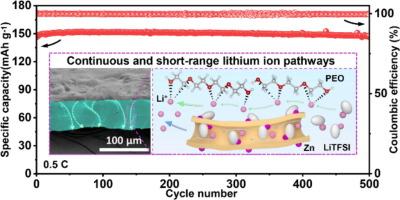Rational design of continuous and short-range lithium ion pathways based on polydopamine-anchored metal-organic frameworks for all-solid-state electrolytes
Abstract
The immerging three dimensional (3D) metal-organic framework (MOF)-reinforced composite solid-state electrolytes have attracted great interest because of the enhanced ionic conductivity and mechanical properties. However, the defective spatial arrangement of MOFs restricted by fabrication methodology leads to insufficient lithium ion transport in electrolytes. Herein, a 3D interconnected MOF framework tailored for all-solid-state electrolytes is rationally designed by a universal polydopamine (PDA)-engineered “double-sided tape” strategy. The PDA serves as a double-sided tape, firmly adhering on the special single-layer Nylon grid as well as offering uniform nucleation sites to anchor the metal nodes to ensure continuous growth of well-ordered MOFs. Benefiting from the Lewis acid feature of MOFs and its cage effect toward TFSI−, a fast and homogeneous lithium ion transport can be achieved through the internal channels within neighboring MOFs and the continuous MOFs/polymer interfaces both along the short-range circumferential boundary of Nylon fiber. The resultant composite electrolytes exhibit high lithium ion conductivity and prominent mechanical properties, rendering excellent cyclic stability whether used in coin or pouch cells. This work demonstrates a widely applicable “double-sided tape” strategy for controllable spatial arrangement of MOF nanoparticles on optional substrates, which provides a scalable approach to rationally construct desired lithium ion pathways within composite electrolytes.


 求助内容:
求助内容: 应助结果提醒方式:
应助结果提醒方式:


